
Concept explainers
(a)
Interpretation:
The detailed mechanism for the given reaction is to be drawn, and the major product is to be predicted.
Concept introduction:
Lithium aluminium hydride (LAH) or
The chemical behaviour of deuterium (
Answer to Problem 17.43P
The detailed mechanism for the given reaction is

The major product of the given reaction:
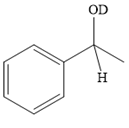
Explanation of Solution
The given reaction is
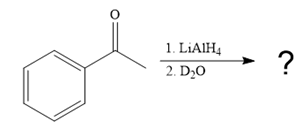
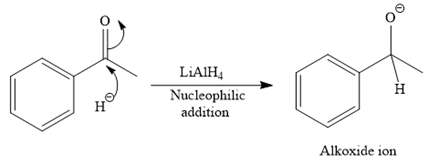
This alkoxide ion then attacks the deuterium (

Thus, the final product of the given reaction is the secondary alcohol shown below:

A ketone, when treated with a reducing agent such as Lithium aluminium hydride (LAH) or
(b)
Interpretation:
The detailed mechanism for the given reaction is to be drawn, and the major product is to be predicted.
Concept introduction:
Lithium aluminium hydride (LAH) or
The chemical behaviour of deuterium (
Answer to Problem 17.43P
The detailed mechanism for the given reaction is

The major product of the given reaction:
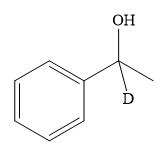
Explanation of Solution
The given reaction is

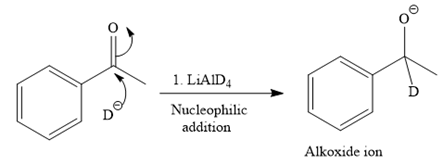
This alkoxide ion then attacks the proton (H) of water, which is the solvent used in the next step.

Thus, the final product of the given reaction is the secondary alcohol shown below:
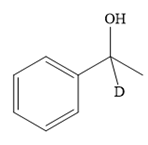
A ketone, when treated with a reducing agent such as Lithium aluminium hydride (LAH) or
(c)
Interpretation:
The detailed mechanism for the given reaction is to be drawn, and the major product is to be predicted.
Concept introduction:
Lithium aluminium hydride (LAH) or
The chemical behaviour of deuterium (
Answer to Problem 17.43P
The detailed mechanism for the given reaction is

The major product of the given reaction:
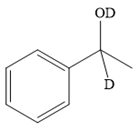
Explanation of Solution
The given reaction is
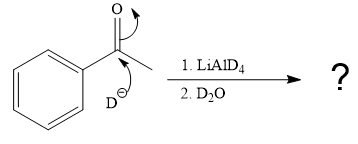
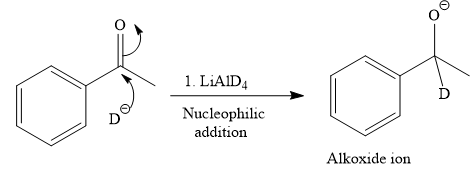
This alkoxide ion then attacks the deuterium (
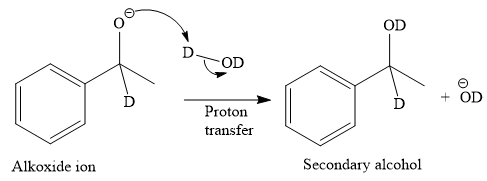
Thus, the final product of the given reaction is the secondary alcohol shown below:

A ketone, when treated with a reducing agent such as Lithium aluminium hydride (LAH) or
Want to see more full solutions like this?
Chapter 17 Solutions
Organic Chemistry: Principles and Mechanisms (Second Edition)
- Predict the major product(s) of each of the following reactions. Draw the complete, detailed mechanism that leads to the formation of each of those products. (b) (c) (a) HO;S HNO3 Cl2. ? H,SO4 ? FeCl3 AICI3 H3CO (d) (e) Br2, ? conc HNO3 ? FeBr3arrow_forwardProvide the complete mechanism in the following reactions.arrow_forwardOrganic Chemistry SUGGEST A MECHANISM FOR EACH STEP OF THE FOLLOWING TRANSFORMATION AND EXPLAINWHY THEY WORK. (TMS is trimethylsilyl). This reaction with the organolithium reagent is similar to an SN2reaction except the nucleophile is reacting at a silicon atom. Please help with problem. thank youarrow_forward
- Shown below is a two-step mechanism beginning with nucleophilic attack of water, and subsequent deprotonation with a base. Draw the arrows for the mechanism for both step 1 and step 2 and draw the intermediate product of in the box. + H-O OH + H₂Oarrow_forwardWhen the following deuterium-labeled compound is treated with potassium tert-butoxide in DMF, a single product is observed. When the same substrate is heated in the presence of dilute potassium ethoxide in ethanol, a mixture of two products is formed. Provide the complete, detailed mechanism (curved arrows) for each reaction and label each reaction as E1 or E2. Note: deuterium is an isotope of hydrogen and can be treated similarly to hydrogen in chemical reactions but cannot be implied. D H KO/Bu DMF D H dilute KOET EtOH ?+ ?arrow_forwardFor each of the following reactions, state the mechanism the reaction will follow (E1,E2, SN1, SN2, etc.) and givethe major product(s) of the reaction.arrow_forward
- Provide the mechanism and the structure of the products A and B in the given reaction.arrow_forwardPredict the product(s) and provide the complete mechanism for each reaction below.arrow_forward(b) While trying to synthesise product A following the reaction scheme shown below, the desired product was never obtained. Instead an unwanted product B was obtained in 100% yield. Provide the detailed mechanism of how this product formed and suggest a new synthesis, starting from the given starting material to obtain product A (No mechanism is required for the new synthesis). مفید مخافه میشود 1. Na OEt 2. Br 1. NaOEt B 2. ge -Br 100 % yield 1. NaOH Heat مبر 0% yieldarrow_forward
 Organic Chemistry: A Guided InquiryChemistryISBN:9780618974122Author:Andrei StraumanisPublisher:Cengage Learning
Organic Chemistry: A Guided InquiryChemistryISBN:9780618974122Author:Andrei StraumanisPublisher:Cengage Learning

